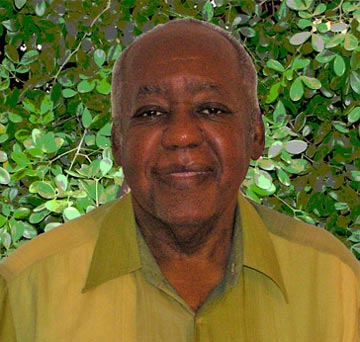English Creole-The Spoken Word on St. John

Mr. Elroy Sprauve,
Educator; SJHS Board Historian.
(Presented by Mr. Elroy Sprauve, March 13, 2007, summarized by Robin Swank)
“ ‘Creole’ is a language patterned from two or more languages by people who live and work together,” Mr. Sprauve began. With wit and charm, he gave lively examples of how English and African, along with Dutch and probably some Spanish and French donations coalesced into the modern patois heard on St John.
Danish was generally not taught or used, so our local patois doesn’t include that influence, Mr. Sprauve reminded us. Dutch Creole was, in its time, spoken by estate managers; the Moravians and Lutheran missionaries also generally spoke it, but it has since died out. English was widely spoken, facilitated by its printed use for school texts and church hymnals. It has remained the “lingua franca,” and like English in London or New York, neighborhood ‘dialects’ were evident even on this small island during Mr. Sprauve’s childhood. “You could tell by a word or accent whether a person lived in Bethany or Gift Hill” he recalled.
“Those you hear speaking English Creole also speak standard English” he reminded us. Mr. Sprauve recalled that the linguistic insecurity imposed on the islands’ children at not speaking standard English was common during his youth, a tactic damaging to a child’s psyche. This has eased in recent times. Adults, however, may still feel insecure about speaking out at a public hearing in Creole, “although” he smiled, “you can certainly hear their opinions afterwards.”
“Creole is not a wordy language”, and understanding some common patterns, he told us, will educate our ear. Here are eight of the grammatical or verbiage ‘patterns’ he presented:
- Forget ‘To Be or Not to Be’—English Creole generally doesn’t use the verb ‘to be’ (And by the end of his presentation, we were convinced it’s an irrelevant verb.) ‘Where John?,’ ‘She my sister,’ ‘My wife no for good,’ and ‘I sick’ are grammatically correct Creole sentences. Tonality is used to sort out, for example, the meaning in the phrase ‘He problem’ between ‘he IS a problem’ and ‘his problem.’ Similarly, ‘He home’ or ‘Mother ill’ can be statements or questions.
- English Creole avoids the letter/sound S. S’s indicating plural are avoided by using ‘dem’ after single nouns, as in “De boy dem” or ‘de goat dem.’ Of course there is an exception; whelks is always plural—I guess because you can’t eat just one. Possessives, instead of being indicated by an apostrophe and a final s are indicated by sentence placement, as in, ‘I play Mary piano.’ The 3rd person present tense also ignores the letter S, as in ‘He speak French.
- Common to African languages, English Creole future and past tenses are not indicated by verb form changes. ‘We play ball next week,’ or ‘She come last week’ are made perfectly understandable with one form of the verb.
- As with most languages spoken over time, Creole fuses words. For example, ‘Where John?’ might be answered by ‘He’en heah.’ ‘You goin’?’ might be answered by ‘No, me’en’ goan.’ With fusion and pace, Mr. Sprauve pointed out, great privacy can be created; he and several other VI college students successfully created private conversations at school in Pennsylvania surrounded by standard English speakers. And it’s done just as successfully today on the streets of St John!!
- English Creole uses cultural ‘substitutions’ and ‘borrows’ from other languages. There are noun substitutions, such as ‘tea’ meaning a full breakfast, or ‘family’ meaning all one’s relatives. The verbs ‘make’, ‘have’, and ‘do’ can be switched around, as they are in other languages—as in, ‘I make 50 (years) yesterday.’ French and Spanish based words such as compadu (godparent), nan or nani (godmother), tanti (aunt) used before a person’s name, soire (as meant in French, a good party with lots of food and dancing), bagashe (baggage) and a fused version of the Spanish todo el mundo, ‘tul mundo, ‘ enrich the English Creole vocabulary.
- Some sounds are glossed over. TH is not pronounced; Three is t’ree and authority is at’ority. Nor are final d’s and t’s accentuated. R’s also seem to be up for grabs; someone using standard English will pronounce lots more final R’s.
- Pronouns as objects of prepositions do not change form; a St Johnian speaking proper English Creole would say ‘Give it to she’ or ‘It is for we.’
- English Creole is continually evolving. There are ‘old’ words, like —porah (disrespectful), swai (wander), and macron (achy or in pain)—macrons were slaves too old to work sugar but not cotton.—that remain. There are also old forms of word usage that still linger; when addressing older respected people fondly by first name, respect requires they be fronted with Friend, Nani, Nan, Miss or Mr. Some usages are waning. Responding to the question ‘How you doin’?’ with ‘Great! Wonderful! Never Better!’ is now more common on the street than ‘so so’, ‘not so bad’, movin’ along’ and other more humble approaches to life. “These people are not hypochondriacs,” Mr Sprauve laughed, “they are respectful that tomorrow belongs to God.” New words continue to enter the Creole vocabulary, through hip-hop, reggae and the Rastafarian influence. “English Creole is a healthy language,” asserts our SJHS Historian. “It is one which needn’t be taught in the classroom, however, because children bring the latest version of it with them to school.”
Mr. Sprauve also noted in his presentation that intense emotions are often expressed in Creole rather than standard English in the home, in Church and sometimes even in the V.I. Legislature. So —T’anks to Mr. Elroy. He presentation preserve English Creole as part of our bilingual St. John heritage. We t’ink he presentation good-good.
See the related items:
[Way of life]

